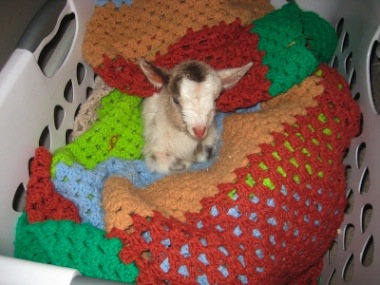I am a bit behind on posts. We just finished three days of steady wind and rain, dropping an impressive 6" of rain on us. Coupled with the 7" we got last week, we are in official "Wet Spring" territory. Oh, I can't wait for Mud Season to be over.
The breeder, whom I deeply respect for her decades of goat knowledge, looked over my doe and then made me an offer. She had pet homes waiting for boys, Jolene was going to have trouble keeping all five fed, I could trade the three boys for an older doeling who was on the bottle. The older doeling would be weaned in three short weeks, leaving Jolene to only feed the two remaining girls, making the demands on her body more reasonable. The boys would be in a good home, not eaten, and the offered doeling is of considerable breeding. Better breeding than any of my other goats, actually.
I didn't have days to think about it because the new homes were open the next day and the boys would go to their new homes immediately. I had to decide then. It took me long hours to reach a decision, loitering around my breeder's farm, weighing the scenarios. I made the decision to make the trade, handed over the three boys, picked up the new doeling, and cried continuously all the way home.
From a purely pragmatic perspective, this was a total coup. I traded three "useless" mouths to feed for a very nice girl, one which would have cost more cash than I could afford if I had to pay for her outright. Jolene would have a much easier time only raising two girls. I would have the potential to get milk from her sooner and expend fewer resources raising goats that were not invested in this farm.
From a personal perspective, however, I was devastated. Not only did I go back on a promise to a friend -- that the boys were hers -- but I went back on a promise to myself and to the goats. When I ventured into breeding, I promised that I would be responsible for all the lives I brought into the world. Collateral damage in the milk industry is all the unwanted males, not unlike the laying chicken industry. I promised those boys that they would never be sold on craigslist for $25 so some stranger can come, hog tie them, and carry them away, terrified, to be butchered in a strange place. Male goats, in this economy, are often only good for food. If it came to that, I would put them down myself, after they had lived a summer and experienced the joys of the sun, the grass, and living a life. Some breeders opt to put the males down at birth. I consider that a waste of a life. Let them live, and in growing, let them then feed my family so they are not forgotten, or wasted. I won't pretend they never existed.
Anyway, I did not sell the boys on craigslist, but I also did not personally vet their new homes. I trust my breeder not to lie to me, that they were in fact good homes. And there's no way she would make the swap just to later eat the boys, so I do know they were destined to be wethered and turned into pets.
Jolene grieved for three days, while still attending to her girls like the wonderful mother she is. And I grieved with her. I grieved for my friend who was so excited to meet the boys. I grieved for the always painful separation of mother and baby. And I grieved for my personal loss of innocence in how to raise animals on the farm. Sometimes the best decision is the hardest decision.
A startling reality of farming, one I had not fully appreciated, is how expendable 50% of the population is. I work in a male dominated field, in a slightly misogynist country, and despite my strong feminist roots, I harbor a lot of my own prejudices. But on the farm, girls rule. Of the 40 something animals I currently keep, only three are males. Only one is intact and actually fulfilling his biological imperative: the rooster. Brego and my one male dog are attractive, useless animals. Even my hamster is female.
I have since followed up on the boys and they are doing well. They took to the bottle just fine and went to their homes. Their new people were so thrilled and excited to raise them. They will be ok.
 Jolene and Amy along the bottom. From left to right - Freya, Katja, and Adalaide.
Jolene and Amy along the bottom. From left to right - Freya, Katja, and Adalaide.















